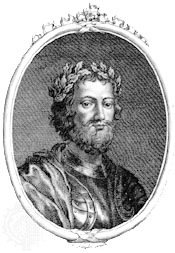Lady Finella
Lady Finella | |
|---|---|
| Born | c. 950 |
| Died | 995 |
| Cause of death | Leapt to her death over a waterfall |
| Known for | Assassinating Kenneth II of Scotland |
Lady Finella (c. 950–995) was a noblewoman[1] and Scottish assassin who killed King Kenneth II (some sources say King Kenneth III[2]) out of revenge.
Her story is based on chronicles from the 14th century.
She was the daughter of Cuncar, Mormaer of Angus, who was thought to be a descendant of Pictish royalty. Lady Finella is a well-known name that is rarely spelled the same way, and is also referred to as Fenella, Finuela, Finnguala, Fimberhele, Strath Finella, Strathfinella Hill, or Sibill, depending on the source.[citation needed] Most of her story is known through John of Fordun's chronicles written in the late 14th century, probably based on local, medieval folklore or 'feud-sagas'.[3] He documented that Lady Finella's son was killed, most likely in battle, by Cinaed at Dunsinnan,[3] a.k.a. Cinaed mac Máel Couim (Kenneth II MacMalcolm, king of Alba[3] (971–995).[1] Lady Finella was possibly enlisted by traditional factions opposed to the king's attempted feudal rule of primogeniture, the right of estates going to the first-born son.


However, the story is that to seek revenge, and with help from the king's men or Cinaed's rivals, Lady Finella created an elaborate death-trap at a cottage in Fettercairn then lured King Kenneth II inside when he was visiting the area.[4] Inside, a statue of a boy stood in the center of the main room. Lady Finella said that if the king touched the boy's head it would lead to 'amazing sport'.[3] When King Kenneth II pulled the statue's head towards him it triggered a series of crossbows throughout the space that sent a hail of arrows into the king. True or not, it is established that Kenneth II was killed in Fettercairn in 995.[4] The story continues that Lady Finella fled towards the coast where she was pursued and cornered by the king's soldiers at the top of a waterfall near St Cyrus. To avoid capture, Lady Finella threw herself over the waterfall from a height of 150 feet[2] to her death. The valley where this supposedly took place is called Den Finella.[4]
References
- ^ a b Wyatt, David (24 April 2009). Slaves and Warriors in Medieval Britain and Ireland, 800 -1200. BRILL. ISBN 9789047428770.

- ^ a b "OS1/19/18/24 | ScotlandsPlaces". scotlandsplaces.gov.uk. Retrieved 25 August 2017.

- ^ a b c d The biographical dictionary of Scottish women from the earliest times to 2004. Ewan, Elizabeth., Innes, Sue., Reynolds, Sian. Edinburgh: Edinburgh University Press. 2006. p. 120. ISBN 0748617132. OCLC 367680960.
{{cite book}}: CS1 maint: others (link)
- ^ a b c By, Undiscovered Scotland. "Lady Finella: Biography on Undiscovered Scotland". www.undiscoveredscotland.co.uk. Retrieved 25 August 2017.

